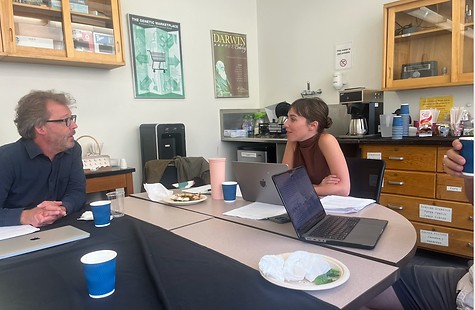This section proposes to establish an international research collective around the politics, history, and social impact of neuroscience and artificial intelligence. Currently, while there are many new interdisciplinary initiatives aimed at assessing the political and social impact of AI and neuroscience, there are none that base their methodology out of collaborations grounded in historical research. Simultaneously, there is a pressing need to build institutions and research networks to scaffold the study of the history of neuroscience and AI from the midcentury to the present. Thus, this section aims to fill these gaps by initiating a research collective that will result in a variety of key scholarly and public facing outputs.
Activities

Understanding Material Intelligence as Historical Problem
The Material Intelligence as Historical Problem (MIHP) project comprises a series of colloquia, training workshops, interdisciplinary working groups, and resulting scholarly output intended for both “public” and academic intellectual audiences. Its aim is to generate new approaches to the question of how material (whether biological or inorganic) entities are correlated to, or “productive of,” the concept-entity of “intelligence” and how it might be understood historically, as well as technically or biologically. Particularly, MHIP aims to establish a research network that takes the West Coast of the United States seriously as a crucial locale in the development of the brain and mind sciences, one with a particular “style” that differed significantly from its well-studied counterparts on the East Coast. MHIP is conceived of and directed by Danielle Carr at UCLA, and funded through the Livescu Initiative on Neuro, Narrative and AI.

In recent years, spurred by broad commercial uptake of Artificial Intelligence and “big data,” there has been a flurry of interdisciplinary scholarly activity around questions of the computational brain at the intersection of science and society; to name only a handful, the list of these types of projects include the Presidential Scholars in Neuroscience and Society initiative at Columbia University, the UCLA-CDU Dana Center for Neuroscience and Society, Stanford University’s Program in Neuroscience and Society, the Neurohumanities Initiative at Duke University, the York University Centre for AI & Society, and many others besides. Undergirding this trend is an implicit premise: that without interdisciplinary scholarly work, the current transformations in how society uses computation will not only not solve social inequalities, but will probably make things much worse.
The MIHP approach agrees with the premise, but disagrees with the resulting diagnoses about what kind of scholarly work those groups should be doing. The panic to address something that feels new “at the intersection of” [sic] brain science and computation generally produces a distinctive formula: conversations between computer and brain scientists, tastefully ornamented by a contingent of “just happy to be there” humanists and sociologists, whose ability to contribute is hampered by the fact that they struggle to understand what the scientists are talking about. The irony is that this this formula aimed at intervening in “the new” is, itself, in both form and content, both quite old and often repeated. Since the first Macy conference (first convened in 1941) at the origin of modern computing, recurrent interdisciplinary groups have convened to reconjugate the question of how the brain is a computer, or vice versa. What MHIP proposes is something different: a working group devoted to historicizing and deconstructing the stakes of this perpetually-recurring scholarly formulation of the question in order to ask it in a new way, and get new sorts of answers.

MHIP will scaffold a critical approach to the neuro-AI disciplinary knowledge cluster that weds technical literacy with historical acuity; one that can thread the needle between political critique, an apprehension of historical zeitgeists, and technical proficiency. In our view, such an approach would represent a novel and much-needed reformulation of this interdisciplinary “space.” The current vogue for interdisciplinary work between the humanities and social sciences, on the one hand, and neuroscience on the other, has become so prevalent as to warrant a name—the so-called “neuro-turn.” Yet a decade after the infusion of funding initiated by the 2013 Obama Brain Initiative, much of this interdisciplinary work remains thin when it comes to a robust and technically-literate interdisciplinary engagement with neuroscience– much less the history of such methods and technologies. By the same token, the tendency of technically-proficient histories of the neuro-AI disciplinary knowledge clusters has generally been to remain “internalist,”—that is, to narrate technical change within a field as a story of technical development (e.g. “the Averaging Response Computer was used to analyze EEGs because it allowed scientists to correlate multiple datapoints”) rather than as contingent developments emerging at the intersection of cultural and political social practices (e.g. “The Averaging Response Computer was the result of Navy-sponsored radar technology being used by ex-military scientists at MIT to collaborate with neurologists in Boston in the post-World War II era, with implications for how brain data was imagined as a surveillance technology that could evade the need for the patient/enemy’s self-report.”)
MHIP aims to scaffold a network of scholars to address the pressing need for technically-proficient and encompassingly-theorized historical accounts of the brain sciences from the 20th century to the present. Practically, this means historical work that not only argues gesturally for the significance of the “rise of the brain sciences” across a variety of disciplines, but can, for instance, connect developments in brain science (e.g. particular configurations of EEG, debates about the nature of synaptic transmission, technical innovations in wireless brain-computer interfaces, and so on) with concurrent debates of pressing cultural and political salience (e.g. linguistic nationalism, the organization of the brain sciences, the politicized nature of military funding, and so on.) In this, our goal is to historicize the perpetual scholarly reformulation of the question (“Are computers and brains the same type of thing, and if so what does it mean for society?”) in order to ask new genres of question: How has this recurrent formulation of the “brain-computer” question transacted organizations of power through modalities of race, empire, gender, and so on? What are the stakes of the universals (e.g. “the human,” “the brain,” “thought,” and so on) presupposed by these formulations, and how have these stakes structured the organization of power from the 20th century to the present? How have technical chances in the neuro-computational knowledge clusters reconjugated or reshaped crucial cultural practices and concepts, with ramifications for the distribution of power in society? And– above all, and as usual– cui bono?
Currently, the number of scholars doing serious, technically-proficient historical work on the mid-century brain sciences in the US and Western Europe, work within a framework of broader cultural and political critique, is small. Our goal is to convene a group of these scholars for symposia and technical training workshops with the goal of both (a) fomenting renewed scholarly interest in this field, and (b) articulating the crucial significance of this field across an interdisciplinary archipelago spanning from the neuro-AI knowledge cluster to intellectual and political history, cultural studies, and critical social sciences.

